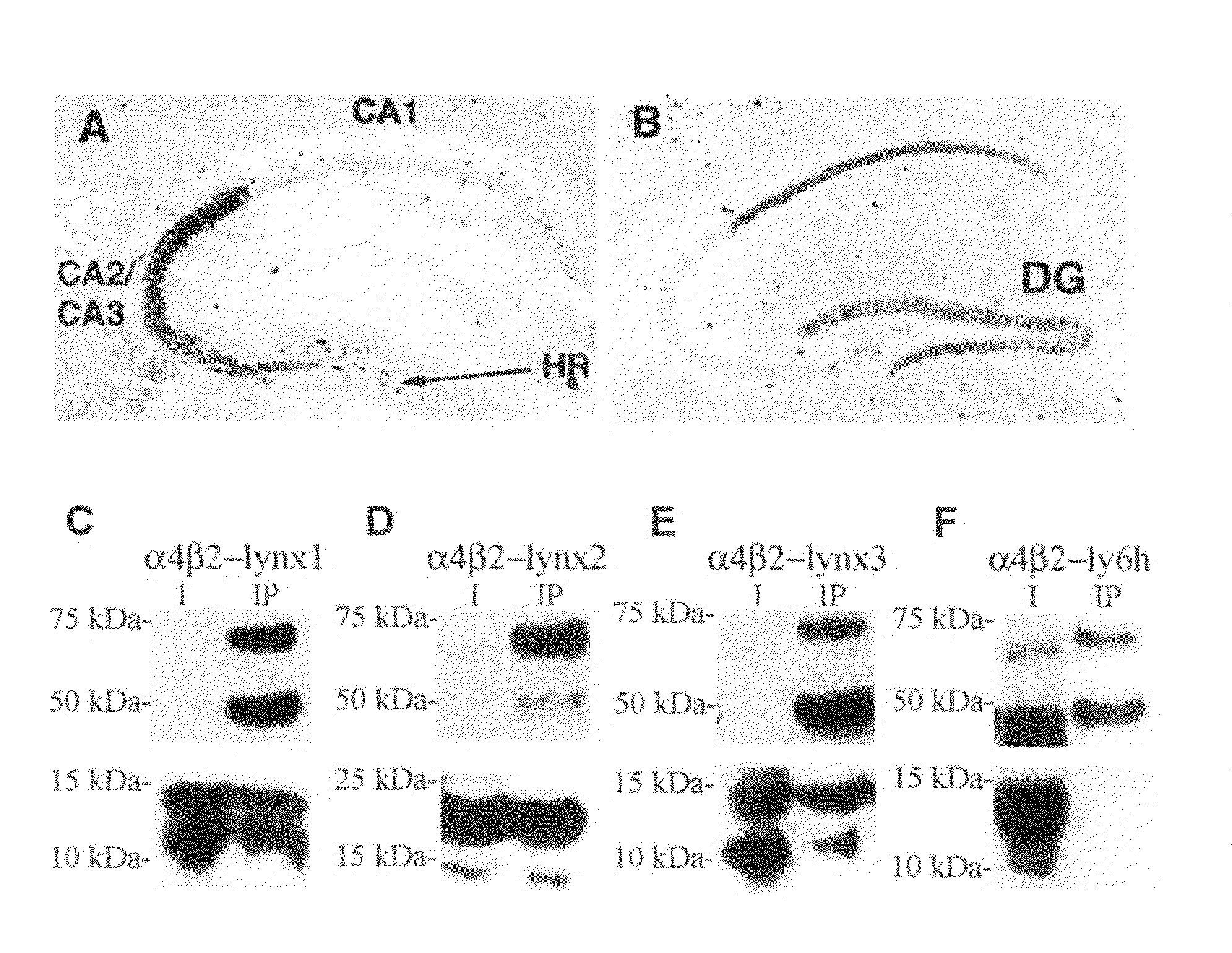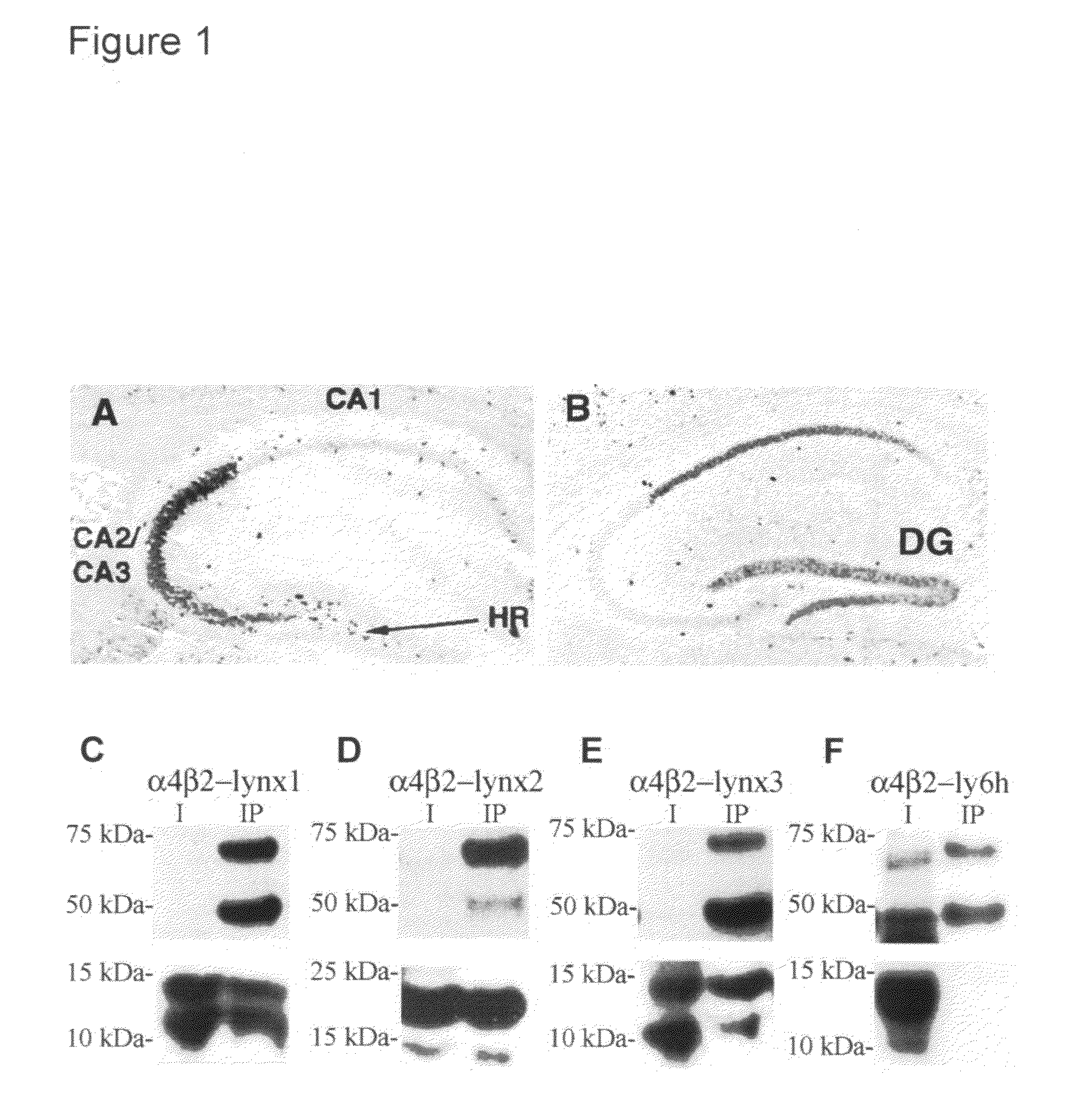Neurobiological compositions
a neurobiological and composition technology, applied in the field of cognitive disorders, can solve the problems of over-activation of nachrs, poor understanding of the contribution of an individual subunit to a given disorder, and increased risk of neuron damage, so as to shorten the duration, lessen the severity, and improve the effect of symptoms
- Summary
- Abstract
- Description
- Claims
- Application Information
AI Technical Summary
Benefits of technology
Problems solved by technology
Method used
Image
Examples
example 1
[0124]Lynx polypeptides were demonstrated to bind the neuro acetylcholine receptor (hereinafter “nAChR”). FIG. 1 shows the interaction between mouse lynx1, lynx2 lynx3, and ly6H, a lynx-related gene, and the nAChRin co-immunoprecipitation experiments. In FIGS. 1A and B, in situ hybridization experiment demonstrate complementary expression patterns of lynx1 and lynx2 genes: in the hippocampus, lynx1 is expressed in the CA2 / CA3 region of the hippocampus, and cells in the hilar region of the dentate gyrus (FIG. 1A), whereas the lynx2 gene is expressed in the CA1 region and to a lesser degree the pyramidaly neurons of the dentate gyrus (FIG. 1B). Figures C-F depict co-immunoprecipitation studies of transiently transfected HEK293 cells with alpha4beta2 nAChRs co-transfected with lynx1 (C), lynx2 (D), lynx3 (E) and ly6H (F), a related family member. Immunoprecipitation experiments were carried out with antibodies to the nAChRs, and the resulting analyte was probed on a Western blot with n...
example 2
[0126]Nicotine-induced currents in lynx1 null mutant mice demonstrate hypersensitivity to agonist. Direct measurements of nicotine sensitivity were carried out using whole-cell patch clamp recordings of neurons in brain slices of lynx1− / − vs. wild-type mice. The medial habenula was chosen for these experiments because of the high level of expression of nAChRs and the co-expression of lynx1 and nAChRs in this region. Application of a 250 ms nicotine pulse to neurons in the medial habenula (FIG. 4B) elicited larger peak responses in slices from lynx1− / − animals than those of wild-type animals (FIG. 4A) for nicotine concentrations between 1 and 20 μM. For the entire tested nicotine concentration range (0.1 μM to 300 μM), the data reveal a decrease in the EC50 from 89.0±2.2 μM in wild-type mice to 9.0±0.7 μM in lynx1− / − mice (FIG. 4C). These currents were blocked by the nAChR antagonist, mecamylamine (mec), and recovered during wash out (middle traces), indicating a specific involvement...
PUM
| Property | Measurement | Unit |
|---|---|---|
| nucleic acid compositions | aaaaa | aaaaa |
| nucleic acid | aaaaa | aaaaa |
| neurological disorder | aaaaa | aaaaa |
Abstract
Description
Claims
Application Information
 Login to View More
Login to View More - R&D
- Intellectual Property
- Life Sciences
- Materials
- Tech Scout
- Unparalleled Data Quality
- Higher Quality Content
- 60% Fewer Hallucinations
Browse by: Latest US Patents, China's latest patents, Technical Efficacy Thesaurus, Application Domain, Technology Topic, Popular Technical Reports.
© 2025 PatSnap. All rights reserved.Legal|Privacy policy|Modern Slavery Act Transparency Statement|Sitemap|About US| Contact US: help@patsnap.com



